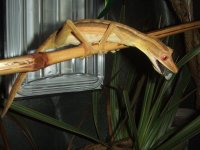jadrig
New member
yeah, lateralis and crickets get the best feeding response...other than moths... It is a shame, especially since 5,000 dubias do not smell nearly as bad as 5 crickets...
Lateralis might be too small for fims though.
Hey Silas...are those the ones that I gave you...mine are all starting to drop oothecas :biggrin: now.
Pakinjak, you are probably right about the dubias coming out at night...I have baited loose lobster roaches into feed bowls by placing carrots or baby food in the enclosure. Fruit will definitely coax the roaches out to where they can be nabbed up, but I dont like roaches running around in enclosures. I was looking for eggs in my P.klemmeri cage and found a dubia that was larger than them with a couple of big lobster roaches.
Lateralis might be too small for fims though.
Hey Silas...are those the ones that I gave you...mine are all starting to drop oothecas :biggrin: now.
Pakinjak, you are probably right about the dubias coming out at night...I have baited loose lobster roaches into feed bowls by placing carrots or baby food in the enclosure. Fruit will definitely coax the roaches out to where they can be nabbed up, but I dont like roaches running around in enclosures. I was looking for eggs in my P.klemmeri cage and found a dubia that was larger than them with a couple of big lobster roaches.




